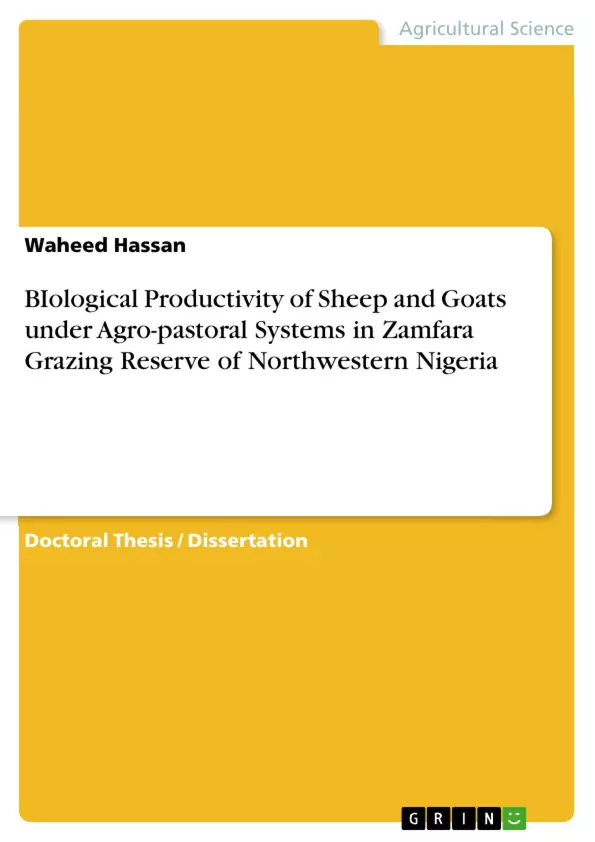The present study had as its main objective an on-farm characterization of the biological productivity of sheep and goats in the Zamfara Reserve.
Sheep and goats form an integral part of most farming systems in Nigeria with over 70 % of the rural households keeping an average of five animals each. The animals are kept mainly for meat production but they also have diverse roles in the sociocultural and economic life of their owners. The population of sheep and goats in Nigeria was estimated at 33.864 million and 21.784 million, respectively. Over 90 % of these animals are kept under village and pastoral systems.
Sheep and goats constitute a large proportion of domestic ruminants in Nigeria. The animals contribute about 35 % of the meat consumed in the nation, although they only contribute 10 % of the ruminant biomass. They also provide milk for human consumption, skin for the leather industry, bone and blood meals for livestock feeding as well as manure for the improvement of soil fertility. In the rural areas, sheep and goats contribute significantly to the nutrition, ecological, socio-economic and socio-cultural well-being of most households. Their socioeconomic importance in rural settlements in Nigeria include, among others, usage as a source of liquidity, means of exchange for labour and usage during ceremonies and religious festivals. However, sheep and goats have remained grossly under-exploited as resources for economic development. The most likely motivation for villagers to improve the productivity of their small ruminants is economic: the opportunity to increase cash income through the sales of animals. Improved productivity of sheep and goats will help towards alleviating rural poverty and improving the living standard of the rural poor.
Inhaltsverzeichnis (Table of Contents)
- INTRODUCTION
- JUSTIFICATION OF STUDY
- OBJECTIVES
- STUDY PLAN
- REVIEW OF LITERATURE
- SYSTEMS OF SHEEP AND GOAT PRODUCTION IN THE SAVANNAH ZONE OF NIGERIA
- Village systems
- Pastoral systems
- Breeds of sheep and goats
- Sources and ownership of stock
- Flock size and structure
- HUSBANDRY PRACTICES
- Stock housing
- Stock grazing and watering
- Supplementary feeding
- Breeding and other routine husbandry practices
- PRODUCTION PERFORMANCE OF SHEEP AND GOATS
- Reproduction
- Lamb and kid mortality
- Growth
- DISEASES AND PESTS OF SHEEP AND GOATS IN THE SAVANNAH ZONE OF NIGERIA
- STOCK OFFTAKE AND DISPOSAL
- MEASUREMENT OF BIOLOGICAL PRODUCTIVITY IN SHEEP AND GOATS
- Individual production traits
- Annual reproduction rate (ARR)
- Productivity indices
- CONSTRAINTS TO SHEEP AND GOAT PRODUCTION IN THE SAVANNAH ZONE OF NIGERIA
- RAPID RURAL APPRAISAL (RRA) RESEARCH METHODS
- Applications of RRA methods in pastoral studies
- Limitations of RRA methods
- Summary and research gaps
- SYSTEMS OF SHEEP AND GOAT PRODUCTION IN THE SAVANNAH ZONE OF NIGERIA
- THE STUDY SITE
- LOCATION AND HISTORY
- ECOLOGY
- TARGET GROUPS
- DIAGNOSTIC SURVEY
- OBJECTIVES
- SURVEY VILLAGES
- INTERVIEW TECHNIQUE AND ANALYSIS OF INFORMATION
- RESULTS AND DISCUSSION
- Survey respondents
- Reasons for keeping sheep and goats
- Sources of foundation stock
- Patterns of stock ownership
- Breeds of sheep and goats kept
- Flock size and structure
- Ownership of other domestic animals
- Husbandry practices
- Some indicators of stock performance
- Offtake and disposal of stock
- Constraints to sheep and goat production
Zielsetzung und Themenschwerpunkte (Objectives and Key Themes)
The dissertation aims to investigate the biological productivity of sheep and goats under agro-silvo-pastoral systems in the Zamfara Reserve, Northwest Nigeria. This study seeks to understand the existing livestock management practices, assess the productivity of sheep and goats in the region, and identify key constraints affecting their performance. The research utilizes a combination of literature review, diagnostic surveys, and Rapid Rural Appraisal (RRA) methods to gather data and analyze the situation.
- Sheep and goat production systems in the Nigerian Savannah zone
- Husbandry practices and their influence on livestock productivity
- Assessment of biological productivity indicators, including reproduction, growth, and mortality rates
- Constraints affecting sheep and goat production in the study area
- The application of RRA methods in pastoral studies
Zusammenfassung der Kapitel (Chapter Summaries)
The dissertation begins with an introduction outlining the justification for the study and its objectives. Chapter 2 provides a comprehensive review of existing literature on sheep and goat production systems in the Nigerian Savannah zone, covering husbandry practices, production performance, diseases, and the application of RRA methods in pastoral studies. Chapter 3 describes the study site, its location, ecology, and target groups. Chapter 4 presents the results and discussion of the diagnostic survey conducted in the study area. This chapter focuses on the characteristics of survey respondents, reasons for keeping sheep and goats, stock ownership patterns, breeds, flock size and structure, husbandry practices, and constraints affecting sheep and goat production.
Schlüsselwörter (Keywords)
The primary focus of this dissertation is on sheep and goat production in the agro-silvo-pastoral systems of the Zamfara Reserve, Northwest Nigeria. Key terms include sheep, goat, biological productivity, husbandry practices, reproduction, growth, mortality, constraints, agro-silvo-pastoral systems, RRA methods, and the Nigerian Savannah zone.
- Quote paper
- Waheed Hassan (Author), 2020, BIological Productivity of Sheep and Goats under Agro-pastoral Systems in Zamfara Grazing Reserve of Northwestern Nigeria, Munich, GRIN Verlag, https://www.grin.com/document/1432038



